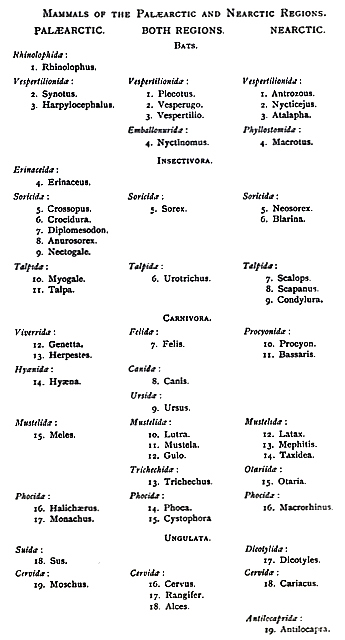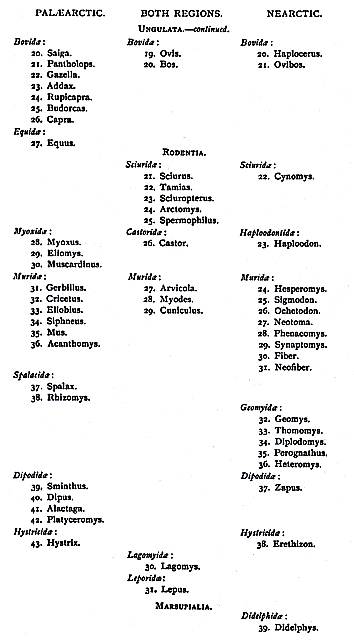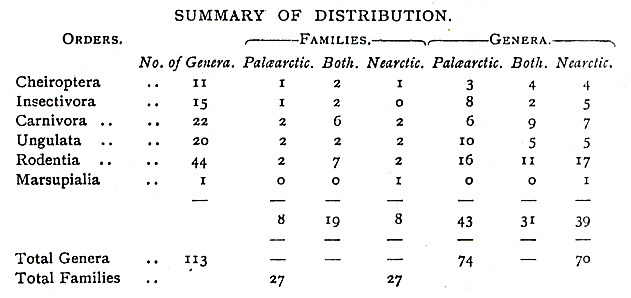|
Russel Wallace : Alfred Russell Wallace (sic) as Regards the Families and Genera of Their Mammalia and Birds (S500: 1894)
These regions were at first generally adopted; but of late years many eminent naturalists, both in America and Europe, have proposed other divisions, though hardly any two of these agree with each other. The most important modification, and that which has been adopted by several zoologists both as regards mammals and birds, is to unite the Palæarctic and Nearctic Regions so as to form one new region, coextensive with the extratropical Northern Hemisphere. This new region, which has been termed the Holarctic, is said to be more nearly equal to the other regions as regards peculiar genera and families, and, therefore, to form part of a more natural and harmonious series than if we treat the two component parts as separate regions. It is this one question only that I propose to discuss in the present paper: whether the Palæarctic and Nearctic Regions, as defined by Sclater, present so many resemblances and so few differences that they can be reasonably considered to form one region as homogeneous as are most of the other regions. The reason why so much difference of opinion exists on this point, when the very same facts are before all the enquirers, seems to be that they treat the facts in different ways. In the first place, it seems to me that far too much stress is laid upon the comparatively small number of absolutely peculiar genera or families in the two temperate [[p. 434]] regions. That may, or may not, be a reasonable ground for deciding that the regions in question are not of equal rank with some other regions; but it cannot justify the union of the two areas unless it can be shown that they are to a large extent homogeneous--that, in fact, the resemblances are more numerous and more important than the differences. In the areas we are discussing, however, this is decidedly not the case, since the facts clearly show that the differences very far surpass the resemblances--that the former are, in fact, fundamental, and are far greater than can be found in the separate halves of any of the other regions, unless they are so divided as to be very unequal in area or to present very great differences in climate. But the Palæarctic and Nearctic Regions are, roughly speaking, equal in area, while they both exhibit the very same range of climate. Any difference that exists between them must, therefore, be due to more fundamental causes; and the most fundamental cause is, that in each case the existing fauna is descended from an ancient, equally distinct, fauna, modified in different ways by immigration from adjacent areas. In dealing with any question of this kind, it is very important that the genera and family groups adopted shall be the same as far as possible throughout the whole area. In order to ensure this, I have, for mammalia, adopted those of Flower and Lydekker in their "Mammals Living and Extinct." In the case of the birds, I am indebted to my friend Mr. H. E. Dresser, both for completing his "List of European Birds" so as to include those of the whole Palæarctic region, and also for so harmonising his genera with those of the "A. O. U. Check List of North American Birds," as to combine the whole into a single series. As Mr. Dresser has made a study of North American birds as well as of those of the Palæarctic Region with which his name is more especially associated, the result is probably as fair and unbiased, for the comparison in question, as can be arrived at. In the case of both regions, I have rejected all those genera in which a single species only just enters the region from the adjacent region to which it properly belongs. Here, again, there is, of course, room for difference of opinion; but the doubtful cases are not sufficiently numerous to introduce any important uncertainty in the result. For both mammals and birds I adopt the same system of presenting the facts which, after much consideration and many trials, seems to me to be the best. The families and genera are arranged in three columns--the first giving those which are Palæarctic but not Nearctic; the third those that are Nearctic but not Palæarctic; the middle column giving those which are common to the two regions--so that by combining this with either of the others we obtain the entire fauna of that region. The results are then summarised in other tables and briefly discussed. We begin with the mammals:--
[[p. 437]] Looking through the preceding lists, we find a remarkable divergence in the characteristic groups of the two regions. Out of fifteen genera of Insectivora, only two are common to both regions; an amount of difference which, if it occurred among larger and better known animals, would produce a striking effect of diversity. In the Carnivora there is a much smaller proportion of peculiar genera, but this is to some extent counterbalanced by each region possessing two families absent from the other. Ungulata, again, show considerable diversity, the Palæarctic Region possessing ten genera and the Nearctic five which are not found in the other. Only five genera are common to both, and of these five, two, Rangifer and Alces, are arctic, while two others, Ovis and Bos, have one species each in the Nearctic Region against about thirteen between them in the Palæarctic. The Rodents, again, have only eleven genera common to both regions, while the Palæarctic has sixteen and the Nearctic seventeen which are not found in the other region. The following summary will enable us to see the total amount of similarity and difference:--
Here we see that in both the regions the number of genera not found in the other largely exceed those common to both, the proportion of the total genera thus limited being 58 per cent. in the Palæarctic, and 56 per cent. in the Nearctic Region; while in each case out of a total of 27 families no less than 8 are so limited. If we compare this amount of diversity with that between the Ethiopian and Oriental Regions, we shall find that, while as regards genera it is somewhat less, as regards families it is considerably greater. In the Oriental Region out of a total of about 72 families of mammals only 8 are not Ethiopian; while in the Ethiopian region out of about 74 families only 10 are not Oriental. No doubt these two regions are those which most resemble each other, and they have been united by some naturalists, but they are now generally admitted to be sufficiently distinct to be classed as separate regions. Great weight has, however, always been given to the possession of peculiar families; and for the same reason the fact that nearly one-third of the families in the [[p. 438]] Palæarctic and Nearctic regions respectively are not found in the other, indicates a fundamental diversity that renders their union into one region quite inadmissible. We will now tabulate the birds, in which the amount of diversity is much larger as regards genera, and equally as large as regards families:--
By merely glancing over these lists we see at once how greatly the genera in either the first or third column exceeds those in the middle column. This tells us that the speciality of each region in relation to the other is very much greater than their similarity. In order, however, to bring out these differences and resemblances more clearly, and to show what they imply, the facts are summarised in the following table of the families, giving the distribution of their genera and species in the same order as in the preceding lists:--
[[p. 444]] The following statement, giving statistics derived from the preceding lists, will complete the information necessary for a comparative view of the relations of the Palæarctic and Nearctic Regions as regards their land-birds:-- The Palæarctic Region has 36 families of land-birds. The Nearctic Region has 32 families of land-birds. The 118 Palæarctic genera which are not Nearctic comprise 472 species. The preceding lists and figures enable us to obtain a very complete view of the amount of difference that exists between the avifaunas of the Palæarctic and Nearctic Regions. Considering first the Family groups, we find that in the one case one-third and in the other one-fourth of the families of the one region are not found in the other; and this is an amount of difference that does not occur between any other two regions which are conterminous with each other. The most striking relation of the Palæarctic and Nearctic Regions is, therefore, not their resemblance, but their dissimilarity. Again, the 12 families which thus differentiate the Palæarctic Region from the Nearctic comprise 22 genera and 57 species; and among them we find such characteristic groups of the Eastern Hemisphere as the accentors, the flycatchers, the starlings, the vultures, and the sand-grouse,--families entirely absent from the whole Western Hemisphere. The 8 families which differentiate the Nearctic Region from the Palæarctic are even more important, since they contain 40 genera and 128 species; and include such characteristic New World types as the Mniotiltidæ, the Icteridæ, and the Tyrannidæ, containing between them nearly a hundred species. Now as there are only 417 species of land-birds in the whole Nearctic Region, we find that between one-third and one-fourth of the whole belong to families which are entirely foreign to the Palæarctic Region. It may be confidently asserted that none of the other regions can be so divided that the two parts shall show an amount of difference at all approaching to this. Yet it is proposed to unite these two regions because they are not sufficiently distinct. They are, however, very much more distinct than are the Ethiopian and Oriental Regions, though the former includes the isolated and peculiar Madagascar fauna. Less than one-twelfth of the Ethiopian families of land-birds are not Oriental, while only one-ninth of the Oriental families are not [[p. 445]] Ethiopian; showing that, by this test of the number of families which are not found in both regions, the Palæarctic and Nearctic are three times as distinct as are the Ethiopian and Oriental Regions. If we now consider the genera which are characteristic of the one region as compared with the other, we shall find equally strong evidence of their diversity. In the Palæarctic Region we have 120 genera which are not Nearctic, out of a total of 174; so that a little more than two-thirds of the Palæarctic genera of land-birds are quite unknown in the Nearctic Region; and these genera contain 472 species out of a total of 767. In other words, out of every 5 land-birds in the Palæarctic Region, 3 belong to genera which are not Nearctic. Looking at the same problem from the other side of the Atlantic, the results are even more striking. Out of a total of 167 genera of Nearctic land-birds no less than 113 are not Palæarctic, the proportion being almost exactly two-thirds. These 113 genera comprise 282 species out of a total of 417 species; so that again almost exactly two-thirds of the Nearctic land-birds belong to genera which are not Palæarctic. This is a larger proportion than in the case of the Palæarctic Region; and nothing can more forcibly bring before us the fundamental diversity of the two areas than the fact that, almost everywhere in the Nearctic Region, out of every three birds we might meet with, two would be generically unknown to the student of the Palæarctic avifauna. There is probably no such amount of difference as this between any two adjacent regions, except perhaps between any two adjacent regions, except perhaps between the Oriental and Australian, the latter admittedly the most isolated on the globe. I have now shown, by a careful comparison of their mammalia and birds, that the Palæarctic and Nearctic Regions, instead of being so much alike that they should be united to form a single region, are really exceptionally distinct. They are certainly much more distinct than are the Oriental and Ethiopian Regions, and are probably quite as distinct as are any two conterminous regions. I feel confident, therefore, that any naturalist who will study the materials I have here brought together in a form to admit of easy comparison, will arrive at the conclusion that the system of Zoological Regions established by Dr. Sclater cannot be improved by the union of two such fundamentally distinct areas as are those which he has termed the Palæarctic and Nearctic Regions. Alfred R. Wallace.
|



